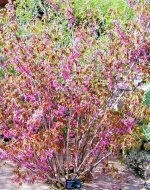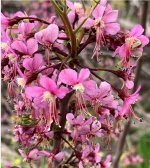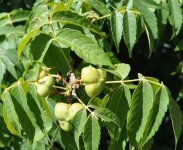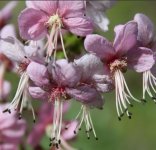Ungnadia speciosa is the sole species in its genus. Mexican Buckeye is not a true Buckeye, but is named for the similarity of its seed. Like maples, horse chestnuts and, of course, soapberries, this tree is one genus of 138 in the Soapberry family. It is ideally suited for this climate, as it is indigenous to Texas, Northern Mexico, and Southern New Mexico.
It seems to also be well-suited to bonsai culture, as it prefers well-drained soils and lots of air for the roots. It is extremely drought tolerant and loves sun.
It is usually a multi-trunked bush or shrub with smooth bark on newer branches that becomes fissured with age. It can, however, be trained as a single-stemmed tree, reaching as much as 30' in height and 8' to 15' at the thickest part of the typical oval canopy.
The leaves are odd-pinnately compound and alternate, starting as a waxy-looking pale green and maturing to a glossy dark green after hardening off. In the fall, they fade into a clear, gentle yellow before drifting to the soil bed below.
In the spring, either just before or with the leaves, clusters of small, showy flowers of bright pink to rose purple emerge. The flowers are about an inch across, having a delicate, pleasant fragrance that attracts many pollinators.
The flowers produce a green tri-lobed seed pod containing a single seed per pod. Seeds mature from July through September; collection is best from August to October as the pods dry out into a rusty brown to mahogany color and split open, releasing the hard, shiny black seeds. The pods persist on the tree throughout the winter, giving a touch of color until new growth pushes them off, having turned black over the course of the season.
















